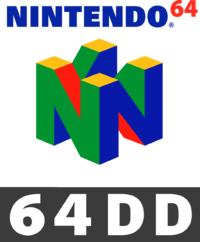Nintendo 64DD: Difference between revisions
Bowserbros (talk | contribs) No edit summary |
No edit summary |
||
| Line 28: | Line 28: | ||
*''[[List of Paper Mario beta elements|Super Mario RPG 2]]'' (released on the Nintendo 64 as ''[[Paper Mario]]'') | *''[[List of Paper Mario beta elements|Super Mario RPG 2]]'' (released on the Nintendo 64 as ''[[Paper Mario]]'') | ||
*''[[List of Donkey Kong 64 beta elements|Donkey Kong World]]'', aka ''Ultra Donkey Kong'' and ''Donkey Kong Universe''. (reworked into ''[[Donkey Kong 64]]'' for the Nintendo 64) | *''[[List of Donkey Kong 64 beta elements|Donkey Kong World]]'', aka ''Ultra Donkey Kong'' and ''Donkey Kong Universe''. (reworked into ''[[Donkey Kong 64]]'' for the Nintendo 64) | ||
===Trivia=== | |||
*If there is no game inserted into the system, the start-up appears as usual but Mario then appears and plays around with the Nintendo 64 logo. | |||
*Even though it was never released out of Japan, some markets outside Japan have sold the system. | |||
==References== | ==References== | ||
Revision as of 13:02, September 12, 2013
Template:System-Infobox Template:LLQuote
The Nintendo 64DD (Nintendo 64 Disk Drive) was a machine that attached to a Nintendo 64 and could play games in a magnetic disc format, the disks containing their own internal memory, written through the N64 instead of the disk itself. There were also several peripherals used for it. It was released in Japan in December 1999. It was scheduled for release in America in 2000, but it ended up being a commercial failure due to the way it was sold (only through subscription to the RanDnetDD online service), so it was never released outside Japan.
There were four Mario games released on this console, all in the Mario Artist series; there were also several cancelled Mario titles. Overall, there were only nine games released on the Nintendo 64DD, although other games planned for the console were released as Nintendo 64 cartridges instead.
Mario series games
Released
- Mario Artist: Paint Studio
- Mario Artist: Talent Studio
- Mario Artist: Communication Kit
- Mario Artist: Polygon Studio
Cancelled
- Mario Artist: Game Maker
- Mario Artist: Graphical Message Maker
- Mario Artist: Sound Maker
- Mario Artist: Video Jockey Maker
- Super Mario 64 2
- Super Mario RPG 2 (released on the Nintendo 64 as Paper Mario)
- Donkey Kong World, aka Ultra Donkey Kong and Donkey Kong Universe. (reworked into Donkey Kong 64 for the Nintendo 64)
Trivia
- If there is no game inserted into the system, the start-up appears as usual but Mario then appears and plays around with the Nintendo 64 logo.
- Even though it was never released out of Japan, some markets outside Japan have sold the system.
